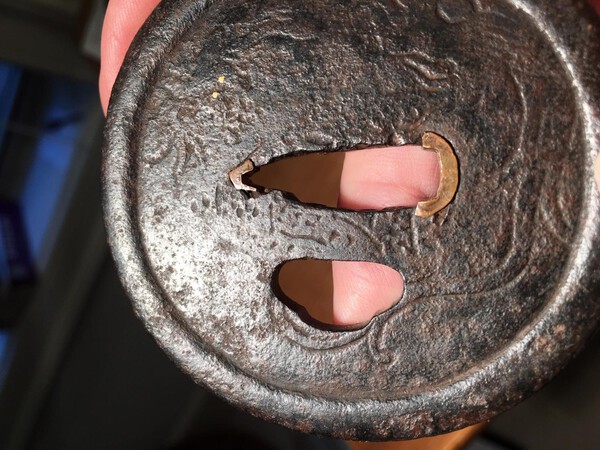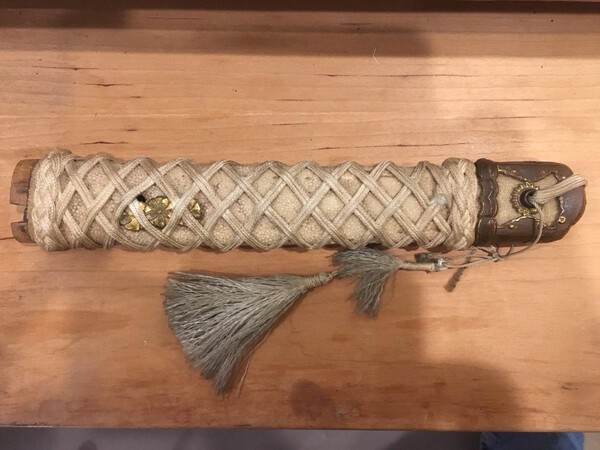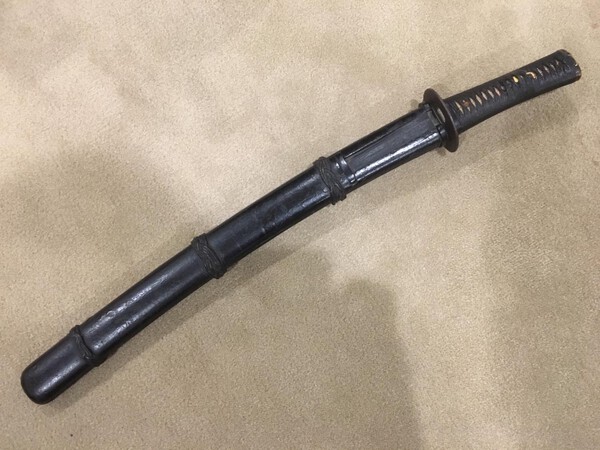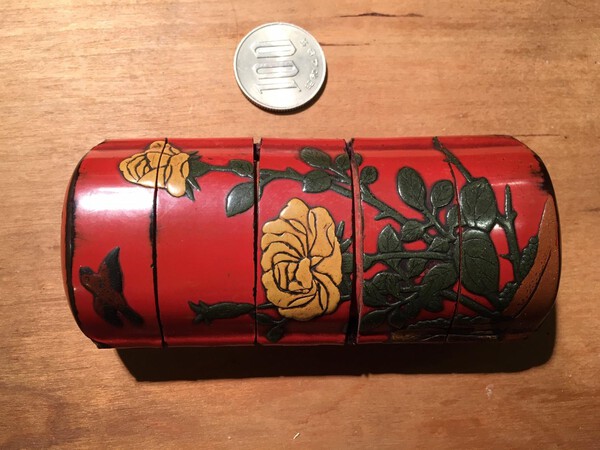
Peter Bleed
Gold Tier-
Posts
1,836 -
Joined
-
Last visited
-
Days Won
8
Everything posted by Peter Bleed
-
James, Thank you for sharing this wonderful tsuba. It seems that this thread has - as they usually do - dissolved across a number of odd topics. Your tsuba - which really is wonderful - moves in a direction I had not suspected. Basically, I was expecting that doing anything to an "old guard" would be negative. We tend to like "ubu" stuff and in that light the addition of "decoration" might seem wrong.I remain convinced that most of the "embelishments" I see are not very good. That is why I was comfortable using an off hand tone about it. It truly think that "old tsuba" were consistently hustled throughout the Edo and Meiji eras. The great bulk of what we see was never very seriously considered. Japan was - as it is today - awash in mediocre stuff. Our job as collectors is to understand that mass and pick out the stuff that is "really pretty good." Ford's comments suggest that some "recycling" can be interesting and even worthy. And your Teruaki tsuba moves that point even farther ahead. Clearly this treatment respected the original piece and used it as a base for a significant new object. Thank you for showing it to us! Peter
-
I beg the wise guidance of this forum. I think I can read the first and third characters of this tsuba mei, but I am not sure about the middle character Is it Minamoto Hisa mitsu ???
-
Juyo Yoshimichi Sword
Peter Bleed replied to Vermithrax16's topic in Auctions and Online Sales or Sellers
Oh, gee, Jeremiah. Don't worry about it. Just go ahead a buy the sword! Peter -
Polishing And Determination
Peter Bleed replied to BIG's topic in General Nihonto Related Discussion
WOW! Peter, How do you find this stuff?! P -
I'm with Pete - and John - of this. My first reaction was that this is a Hoan plate - - that got whored up by a later embellisher who knew how to add a bit of glitter. It also speaks to my larger point that some/lots of "old iron" tsuba were available to later Edo period metal workers and used by them to produce fancy stuff. Our challenge is figuring out how to treat these later embellishments. Should be ignore them, remove them, or embrace them - - if we like them. Peter
-
Dear BaZ, Well, maybe I was trying to be a bit incendiary with my comments about gomoku zogan. Some of it has a bit of charm, but to my eye it ALWAYS looks like something that was hung on an older plate. I can't suggest a French word for it, but to place it in a term d'Aus I think of it as something like Chicken Parm. Peter
-
Zach, I think you have a nice tsuba and that you acquired in a positive way. Congratulation! I think Shingen tsuba fall into a category of "samurai" weaponry. Maybe they should be viewed as "militaria" rather than "art". In any case, I think they truly reflect the samurai culture and activities. From my experience they are not common, but I remember when they use to show up with missing elements and pieces. I wonder if some of the ones we see nowadays may not have been repaired and restored. There is NOTHING wrong with that. It may simply be a part of sword history. Look closely and see if you can see evidence of repair. Peter
-
Information On Tachi Menuki In Custom Fitted Box
Peter Bleed replied to Yoshimichi's topic in Tosogu
I think they're darn nice. P -
Richard, Thank you for your response. And I take your point, but I remain unconvinced. I am currently looking at a sample of katchushi tsuba that include a few unembellished guards that are basically just like the far more common types that have a bit of nunome or Heianjo type brass inlay. It is easy for me (naively, I'll admit) to see these embellishments as additions on older iron discs. We DO know that there was trade in old sword fittings at flea markets etc during the Edo period, We also know that lots of tsuba-ko started with iron plates made by guys who specialized in producing them. You are certainly correct in pointing out that addition embellishment would be work, but that is what those guys did. I think It is likely that a skilled specialized could rather easily drop bit of inlay on a finished tsuba. That's what those guys did! Maybe it was apprentice work. Beyond all that, I have to say that a lot of mid-Edo embellishment just looks like hack work. We all like Heianjo brass but I'm sure that a guy who was set up to knock it out could cut a bit of vine, lay in a piece of fine wire, pound down a V-shape leaf and sell it for the cost of dinner. And then there is all that awful gomoku-zogan that shows up on old iron guards. Maybe it was some kind of retro punk stuff that appealed to the urban masses or returning travelers who needed trinkets to bring home from the City. But it seems a long way from Yamato Damashi! Again, thanks for your response. Peter
-
I have recently become interested in the possibility that older iron tsuba were embellished, decorated, and repurposed during the Edo period. Has anyone discussed the possibility that older iron guards were pimped out by Edo kinko? Peter
-
My bet is KANEMASA as in KAN 1355 Peter
-
A Word Of Warning!
Peter Bleed replied to Ken-Hawaii's topic in Auctions and Online Sales or Sellers
I agree with Grey. The bones of this guard just seem suspicious. And that goes for other guards on this guy's site. Look at the slick dragons on this putative Heianjo tsuba! https://www.ebay.com/itm/Tsuba-Japanese-Samurai-Sword-Katana-Antique-15/163283810834 The entire seppa-dai is fresh and clean Peter -
Shirasaya Sayagaki Translation Needed
Peter Bleed replied to Ed Hicks's topic in Translation Assistance
This was a great thread that I got to late. I wish I had been able to dive in instead of simply watching others. Thank you NMB! Interesting sword, Ed. Thanks to you, too! Peter -
Ray, By the way, I think it is good that you have made your knottery public. Peter
-
Ray, Please let me add to your naval gazing. The first of these images shows a gunto tsuka that seems to have had its maki replaced with shiney white nylon cordage. I kept it because it came with a Bakumatsu Sendai Munetoshi katana. The story that came with this sword was that the Navy feared lice would be in the "web gear" so that the original wrap had to be removed. The other blade is a wakizashi made from a crappy old naginata. It has a very nice tsuka, but a coarsely repaired saya closed with three "Turks head" knots that were painted over. Believe it or not, this is the very first Japanese sword I ever bought! Thank you Andy Quirt! Peter
-
Michael, You can begin investigating your sword by searching for "Hizen Tadayoshi". I bet you will find images to compare with your sword. You might also consider looking at basic sources that discuss blade shape. They will help decide if the tip of your sword has been heavily modified. Peter
-
very nice.I suggest a bit of light oil to the iron. P
-
Thank you for all of this useful information. I am informed, even if I am not enriched! Peter
-
I agree with with Steve, that this does not look like a surrender tag. A pawn marker, maybe? Peter
-
Friends, I beg the help of the NMB on a recently acquired inro. Can anyone give me advice in this piece, please...? Peter
-
In the world of habaki, nothing is common! Peter
-
My assessment is that this is a classic kazeuchi Bizen-to dating from the Muromachi that was found completely suitable for service as an officer's sword. I also agree that it wears a rather blocky umegane repair. These are not desirable but they also are not all that negative. It looks like a nice and very collectible shingunto. Peter
-
Indeed it was fun. This blade truly does look older than Muromachi, but I can also see how all those Kyushu schools could kind of collapse toward one another as time passed. Thanks!





